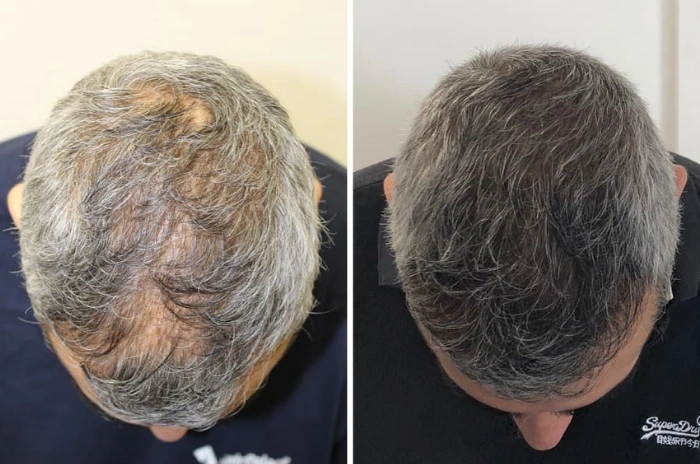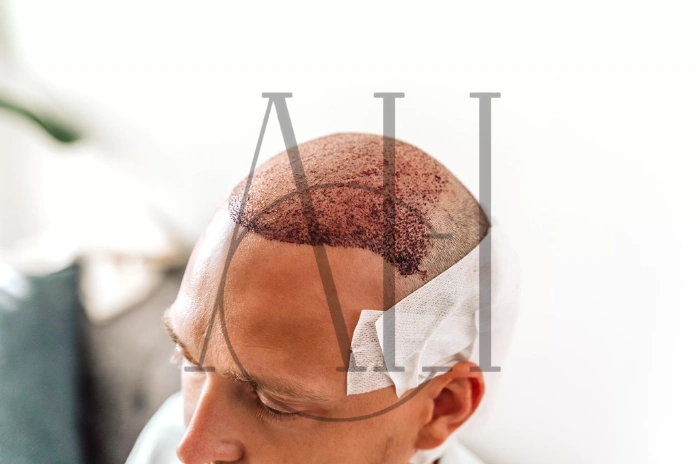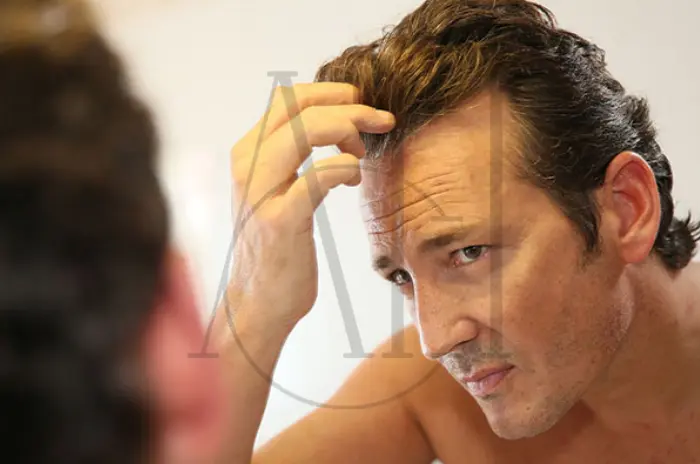Hair loss affects millions of people worldwide, causing both aesthetic concerns and emotional distress. While traditional treatments like medications and transplants offer some solutions, they often provide limited results. Gene therapy for hair loss represents a revolutionary approach that could transform how we treat baldness and alopecia.
This cutting-edge technology targets the root causes of hair loss at the genetic level. Instead of simply masking symptoms, hair loss gene therapy aims to restore natural hair growth by correcting the underlying biological mechanisms that cause follicles to stop producing hair.
Scientists are developing innovative techniques to wake up dormant hair follicles and extend their growth cycles. These approaches include SCUBE3 hair growth research, exosome hair therapy, and CRISPR and hair regrowth studies that show promising results in early trials.
Table of Contents
ToggleWhat Is Gene Therapy for Hair Loss?
Gene therapy for hair loss is a medical treatment that uses genetic material to restore hair growth. This approach involves introducing specific genes, proteins, or molecules into hair follicles to correct the biological processes that cause baldness.
Unlike traditional treatments that work on the surface level, gene therapy hair growth targets the cellular mechanisms responsible for hair production. The therapy can involve delivering growth factors, activating dormant stem cells, or modifying gene expression in hair follicles.
Current research focuses on several key areas. Scientists are studying hair follicle gene editing techniques that can reprogram cells to produce hair more effectively. They’re also exploring stem cell therapy for hair loss that involves injecting modified cells directly into the scalp.
Regenerative hair loss treatments using gene therapy show particular promise because they address multiple causes of hair loss simultaneously. These treatments can potentially restore hair in areas where follicles have been dormant for years.
The technology builds on decades of research into hair biology and genetics. Researchers have identified specific genes and pathways that control hair growth cycles, providing targets for therapeutic intervention.
Why Hair Follicles Stop Growing
Understanding why hair follicles stop producing hair is crucial for developing effective gene therapy for alopecia. Hair loss typically occurs when follicles enter a prolonged resting phase and fail to restart their growth cycle.
Several factors contribute to follicle dormancy. Genetics plays a major role, particularly in male and female pattern baldness. Specific genes make hair follicles sensitive to hormones like dihydrotestosterone (DHT), which gradually shrinks them over time.
Age-related changes also affect follicle function. As we get older, hair follicle stem cell wake signals become weaker. The stem cells that normally regenerate hair become less active, leading to thinner hair and eventual baldness.
Inflammation and poor blood circulation can further damage follicles. When the scalp environment becomes hostile to hair growth, follicles may shut down permanently to protect themselves from further harm.
Environmental factors like stress, poor nutrition, and chemical damage can accelerate hair loss. These factors disrupt the delicate balance of growth signals that keep follicles healthy and active.
Modern hair loss research has identified key proteins and pathways involved in these processes. Scientists now understand that reactivating dormant follicles requires precisely timed interventions at the molecular level.
How Gene Therapy Works
Gene therapy hair growth treatments work by delivering therapeutic materials directly to hair follicles. Scientists use various delivery methods to ensure the genetic material reaches its target cells effectively.
One promising approach involves microneedle patch alopecia treatments. These patches contain tiny needles that penetrate the scalp and deliver therapeutic genes or proteins directly to hair follicles. The patches dissolve over time, providing sustained release of active ingredients.
SCUBE3 hair growth research represents another breakthrough in the field. Scientists discovered that the SCUBE3 protein plays a crucial role in activating hair follicle stem cells. Gene therapy can deliver this protein or instructions to produce it directly to dormant follicles.
Exosome hair therapy uses tiny cellular packages to transport genetic material. Exosomes naturally carry messages between cells, making them ideal vehicles for delivering therapeutic genes to hair follicles without triggering immune responses.
CRISPR and hair regrowth studies explore using gene editing to modify hair follicle DNA directly. This approach could potentially correct genetic defects that cause hair loss or enhance the follicles’ ability to produce hair.
The therapy typically involves multiple treatment sessions spaced several weeks apart. Each session builds on the previous one, gradually reprogramming follicles to resume normal hair production cycles.
Current Research and Trials
Hair loss research in gene therapy is advancing rapidly, with multiple clinical trials underway worldwide. Several companies and research institutions are testing different approaches to regenerative hair loss treatments.
Early-stage trials have shown promising results for gene therapy for baldness. Some studies report significant hair regrowth in patients who had been completely bald for years. These results suggest that even severely damaged follicles can potentially be restored.
Stem cell therapy for hair loss trials are particularly encouraging. Researchers inject modified stem cells into the scalp, where they integrate with existing follicles and boost hair production. Some patients have experienced 30-40% increases in hair density.
SCUBE3 hair growth studies have demonstrated the protein’s ability to wake up dormant follicles in laboratory settings. Human trials are now testing whether delivering SCUBE3 through microneedle patch alopecia treatments can produce similar results in patients.
Several hair follicle gene editing studies are in early phases. These trials use modified viruses or nanoparticles to deliver therapeutic genes directly to follicle cells. Initial results show improved hair growth in treated areas.
Exosome hair therapy research is also progressing well. Clinical trials are testing whether exosomes derived from healthy hair follicles can restore function to damaged ones. Early data suggests this approach may be particularly effective for autoimmune hair loss conditions.

Gene Therapy vs. Traditional Hair Loss Treatments
Gene therapy for hair loss offers several advantages over traditional treatments like medications and transplants. While current options provide temporary or limited solutions, gene therapy aims to create permanent changes at the cellular level.
| Treatment Type | Duration of Results | Side Effects | Coverage Area | Cost (Long-term) |
|---|---|---|---|---|
| Gene Therapy for Hair Loss | Potentially permanent | Minimal | Full scalp | High initial, low maintenance |
| Hair Transplant | Permanent for transplanted hair | Scarring, infection risk | Limited to donor area | High upfront cost |
| Minoxidil | Temporary (requires daily use) | Scalp irritation, unwanted hair growth | Applied areas only | Ongoing monthly costs |
| Finasteride | Temporary (requires daily use) | Sexual dysfunction, mood changes | Systemic effect | Ongoing monthly costs |
| Stem Cell Therapy | 1-2 years | Minimal | Treated areas | Moderate, periodic sessions |
Hair transplant surgery moves existing follicles from one area to another but doesn’t create new hair. Hair loss gene therapy can potentially reactivate follicles throughout the scalp, providing more comprehensive coverage than transplants.
Medications like minoxidil and finasteride require daily use and often lose effectiveness over time. Gene therapy hair growth treatments could provide long-lasting results with just a few sessions, eliminating the need for daily medication routines.
Traditional treatments often have significant side effects. Finasteride can cause sexual dysfunction, while transplant surgery involves scarring and recovery time. Regenerative hair loss treatments using gene therapy typically have fewer side effects because they work with the body’s natural processes.
Cost considerations also favor gene therapy in the long term. While initial gene therapy for alopecia treatments may be expensive, they could eliminate the ongoing costs of medications and multiple transplant procedures.
However, traditional treatments are currently more accessible and have longer safety records. Hair loss future treatments using gene therapy will likely complement rather than completely replace existing options.
Can You Try Gene Therapy for Hair Loss Now?
Currently, gene therapy for hair loss is not widely available for routine treatment. Most approaches are still in clinical trials or early research phases, limiting access to study participants.
Some experimental treatments are available through clinical trials. Patients interested in hair loss gene therapy can search for ongoing studies that match their specific type of hair loss. Trial participation often provides free treatment but requires meeting strict eligibility criteria.
A few specialized clinics offer early versions of stem cell therapy for hair loss and exosome hair therapy. These treatments are expensive and not covered by insurance, as they’re considered experimental procedures.
Microneedle patch alopecia treatments are closest to market availability. Several companies are seeking regulatory approval for patches that deliver growth factors and proteins to hair follicles. These could become available within the next few years.
Patients considering experimental treatments should thoroughly research providers and understand the risks involved. Gene therapy for baldness is still evolving, and long-term safety data is limited for most approaches.
The regulatory approval process for hair follicle gene editing and CRISPR and hair regrowth treatments will likely take several more years. These technologies must undergo extensive safety testing before becoming available to the general public.
FAQ :Gene Therapy For Hair Loss
What is gene therapy for hair loss?
Gene therapy for hair loss is a treatment that uses genetic material to restore hair growth by targeting the cellular mechanisms that cause baldness.
How does gene therapy work for hair follicles?
Gene therapy hair growth works by delivering therapeutic genes, proteins, or molecules directly to hair follicles to reactivate dormant stem cells and extend growth cycles.
Can you get gene therapy now?
Hair loss gene therapy is mainly available through clinical trials, with some experimental treatments offered at specialized clinics, but it’s not yet widely accessible.
How does it compare to a hair transplant?
Unlike hair transplants that move existing follicles, gene therapy for alopecia aims to reactivate dormant follicles throughout the scalp, potentially providing more comprehensive and permanent results.




